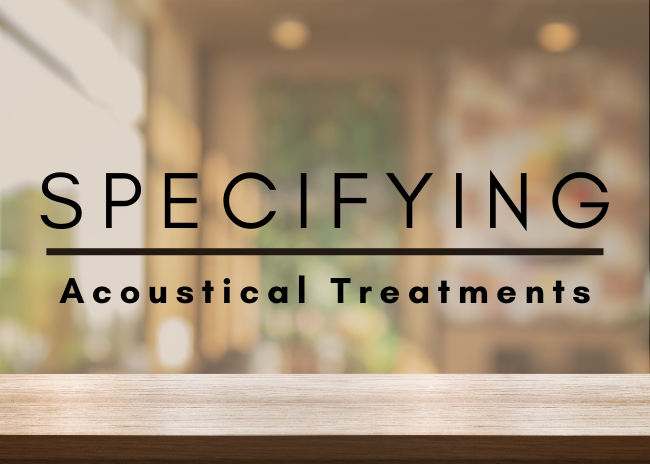No restaurant patron wants to shout across the table to be heard. Nor do they want to dine in a dead quiet space. The main purpose of acoustical treatments in restaurants is to enhance the customer’s experience by providing a balanced auditory environment. Sound control is often overlooked in design and can be costly to rectify.
In restaurants, the goal is to control sounds within the space by using soundproofing and sound absorption materials. While the former stops sound from leaving one space and entering another, the latter weakens sound’s transfer in the space.
Surfaces and materials have different sound absorption properties that come into play when factoring in acoustics. Time of day, location, room shape and height should also be factored in.
An Atmospheric Perspective
The longer a customer sits in a space, the more important acoustics become. While hiring an acoustic consultant may be recommended for fine-dining establishments or restaurants with live music, noise mitigation expectations are not as high for fast-casual or quick-service operations.
A restaurant’s layout impacts acoustical treatments. Sound control may not be as important at the bar or by an open kitchen, where a livelier atmosphere is expected. However, louder sounds should not bleed into more intimate dining spaces or private rooms.
The biggest sound issue in restaurants is reverberation or echo. This is the summation of all reflections off of the walls, ceiling and floor. Every room has six surface areas, with each contributing 17% to the reverberation. It’s best to keep reverberation down to 1 or 1½ seconds, which is how long sounds stays in the room.
Ideally, acoustical treatments should cover about 70% of the walls and ceiling, but this is costly. Also, the goal is to integrate sound proofing and absorption materials into the restaurant’s design but because many facilities are retrofits this is not always possible. Fortunately, soundproofing aesthetics have greatly evolved.
One of the most common mistakes is underordering acoustical material for the rate, level of absorption and surface area coverage needed.
Materials and Location
Noise reduction coefficient (NRC), ceiling attenuation class (CAC) and sound transmission class (STC) are laboratory measurements of material absorption. The higher the rating, the better. Noise isolation class (NIC) is a number rating using measured values of noise reduction. Sabin is the unit of measure for total sound absorption of an acoustical object.
The acoustical treatment industry has come a long way in creating materials that are more sound absorbent but because of appearance, cost and cleaning restrictions, some are not suitable for restaurants.
The most economical treatment is fabric-wrapped foam panels, which can easily be cut in various shapes and sizes for wall hanging. These offer various thicknesses, colors and fabric types as well as image transfer capabilities. Fiberglass panels are popular and customizable as well. Panels can be filled with denim, cotton or fiber. For those not wanting to hang panels, dense drapery in six to eight layers provides the same effect as 2 inches of foam.
PET felt is decorative, available in multiple colors and shapes, and can be used in a wide variety of acoustical applications. When used with additional insulation, drywall and plaster are sound control options that provide a finished look and durability in new builds. Vinyl with a leather-like appearance is another acoustical treatment option.
Because many perimeter restaurant walls are glass, which doesn’t absorb sound, it’s common to treat the area above windows with acoustical material.
Sound can be more easily absorbed and trapped in ceiling applications than in floors. Hanging baffles and clouds are commonly used for this as well as acoustic wood products that may be perforated. Other options include spray insulation on ceiling slabs or panels. Due to scientific advancements, operators can get the look of a wood-paneled ceiling with micro perforation products. Ceiling tiles are a more affordable sound control option if eye appeal is not a big factor.
Exposed ceilings with an industrial look are on trend but more difficult to deal with acoustically. In this case, vertical baffles provide a better NRC rating and sound control. Layering materials above also is effective, and pockets can be created to hide absorbent material. Acoustical panels positioned between joists and wooden ceilings with gaps also help trap noise.
Because restaurant floors are often hard surfaces, like concrete, porcelain tile or wood, these are generally not treated acoustically in restaurants. There is some sound absorption from customers since people in the space are equivalent to 12 square feet of carpeting. Also, adding a floor underlayment or using textured hard surfaces will provide some noise absorptive quality.
Lighting fixtures, window treatments, upholstery, finished surfaces and even plants play a part in acoustics. Also, artwork, such as canvas prints, will have a mitigating impact on sound, and even more so when containing acoustical material.
Purchasing Considerations
Sound plays a big part in customers’ experience and memories of a restaurant, so any aspect of a design that creates or deadens noise makes an impact. Focusing on acoustical treatments from the beginning is recommended, as it can cost more to add it in later. These treatments are considered front-end design elements.
Operators should consider what they’re looking to achieve acoustically. Those with bigger budgets can hire an acoustic consultant who can provide balance and program the spaces and their transition. This becomes more important for operations with live music.
The menu, kitchen equipment, number of employees and overall energy of the space will impact acoustical treatment needs. Along with the space’s length, width and height, the ability to break up room components should be considered.
Architectural calculators can factor in the amount of untreated reverberation time at different decibels using space dimensions and finished surfaces. This provides better insight into what acoustical treatments are needed. For example, if a 30-foot-by-45-foot space with a 10-foot ceiling has a reverberation time of 3.2 seconds, the amount of paneling needed to get the number down to a preferable 1.5 seconds can be calculated. It also will determine the amount of materials needed and how it should be dispersed throughout the space.
Most building codes mandate the use of fire-resistant acoustic materials. The Class A fire rating means that the acoustic wall treatment received the highest rating possible under the ASTM E-84, a test that measures the burning characteristics of building materials.
One of the most common mistakes is underordering acoustical material for the rate, level of absorption and surface area coverage needed. If 30 square feet of treatment is used on one wall, then 30 square feet will be needed on another to balance the sound level. Reverberation times cannot be adequately reduced by only treating the ceiling. At least three surfaces minimum, or 70% coverage, is required to make a noticeable difference.
Utilizing material that’s too thin should be avoided. Depending on the restaurant’s noise level, a thickness of 2 to 4 inches minimum is recommended. By the same token, using too much material will muffle sound, creating a too quiet, uncomfortable environment.
Cleaning and maintenance considerations affect both material choice and acoustical treatment placement. More durable surfaces, such as wood, plastic, heavy fabric or vinyl, can be installed at the customer level. Soft, plush materials, which will require more cleaning and are less durable, disintegrate or retain bacteria, should be avoided.
Most acoustical treatments can be spot cleaned by dabbing surfaces with a moist cloth or towel. Soft ceiling materials should be dusted regularly. Smooth, perforated products are easier to clean.
For best results, operators should discuss the acoustics and sound goals with architects at the beginning of the project’s design phase.




